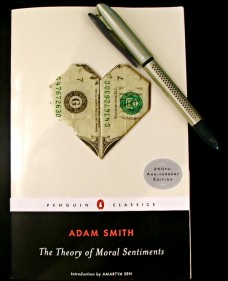
The intention with this, and a series of blog posts, will be to share my on-going reading of the theory of moral sentiments, and this first post is about the first chapters on sympathy in particular.
The Theory of Moral Sentiments - or TMS for short - was Smith’s first book, published in 1759, but with its popularity and Smith’s editing it eventually made it into its sixth edition in 1790, re-published just months before Smith’s death - and so it also became Smith’s last book as it were.
Many historians have pointed to this work as Smith’s better work, but as ever, the proof is in the eating. What is really interesting is Smith’s immediate and broad definition of the wants and passions of people - or what drives utility maximisation in agents - in the opening line of the opening chapter:
How selfish soever man may be supposed, there are evidently some principles in his nature, which interest him in the fortune of others, and render their happiness necessary to him, though he derives nothing from it except the pleasure of seeing it. (Smith 1757 [1790: I.I.1])
Smith goes on to discuss how people’s ability to sympathise, and receive sympathy, depends on the situation, the subject and the circumstances under which sympathy is given. I.e. people (agents) have assymetric reactions to whether people support what we like and what we hate.
We can forgive them [our friends] though they seem to be little affected with the favours which we may have received, but lose all patience if they seem indifferent about the injuries which may have been done to us: nor are we half so angry with them for not entering into our gratitude, as for not sympathizing with our resentment. (Smith 1757 [1790: I.I.18])
After the first four chapters/sections (of which the fourth is simply called “The same subject continued”) people and the preferences they have appear much more complex and diverse than the story we are used to about Smith as a utility maximizing kinda-guy. Amartya Sen introduced the 250th anniversary edition (which I am reading) and launches straight into ‘Das Adam Smith Problem’ as it were - which is the perceived divide between Smith’s views on agent maximising behaviour. Sen rejects even the premise of such a discussion, saying that readers have read what they want in The Wealth of Nations.
Further, following that fashion in modern economics, a whole generation of rational choice political analysts and of experts of so-called “law and economics” have been cheerfully practicing the same narrow art. And they have been citing Smith in alleged support of their cramped and simplistic theory of human rationality… While some men are born small and some achieve smallness, it is clear enough that Smith has had much smallness thrust upon him. (Sen 2009: x-xi)
The Theory of Moral Sentiments was published in its final edition a year after the last version of The Wealth of Nations so there is much merit in the notion that there is just the one Smith, and the one set of opinions about rationality, the market and people. Either way, it’s been a very good read so far, and I will keep you posted!




